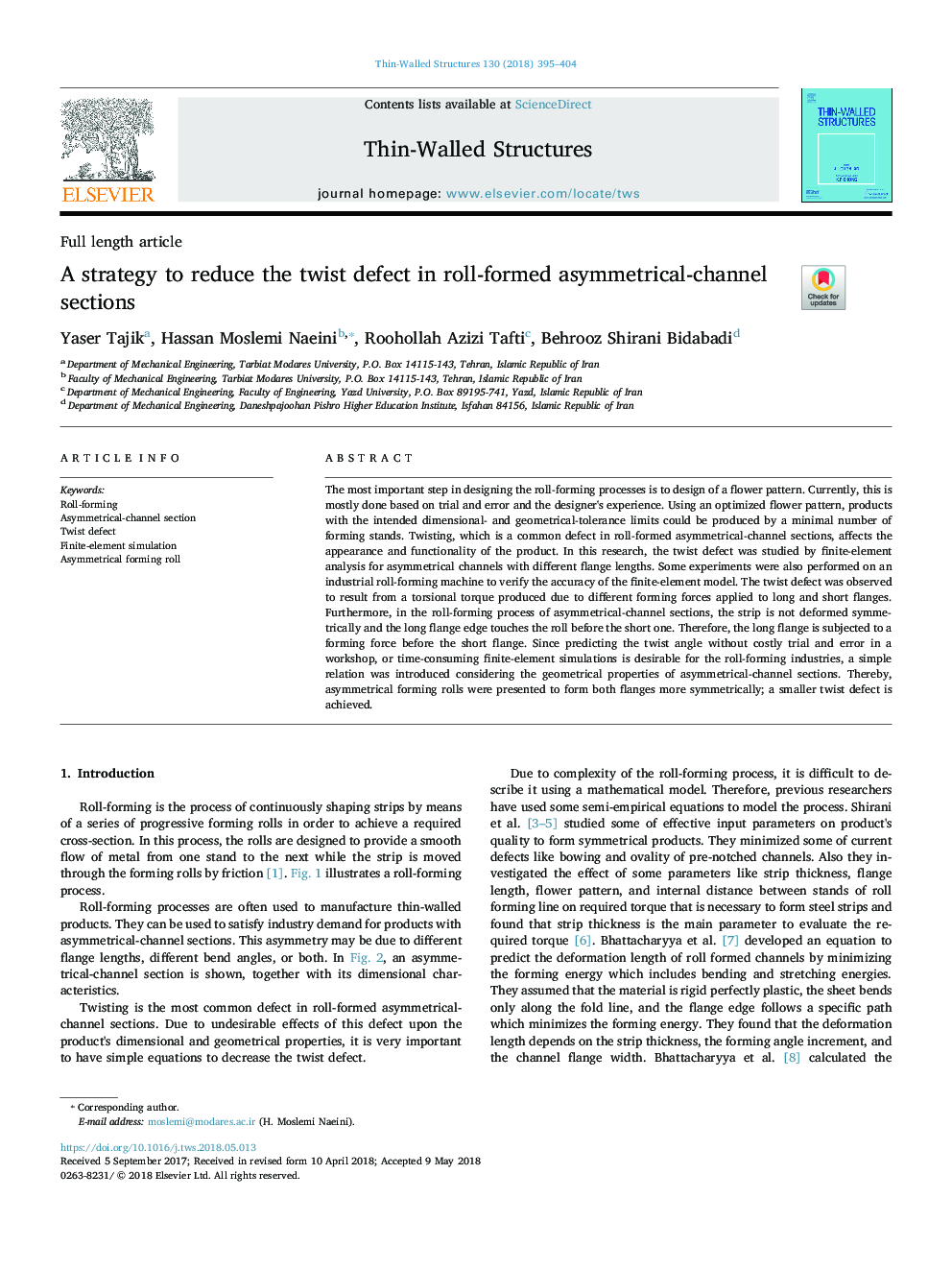| کد مقاله | کد نشریه | سال انتشار | مقاله انگلیسی | نسخه تمام متن |
|---|---|---|---|---|
| 6777312 | 1432061 | 2018 | 10 صفحه PDF | دانلود رایگان |
عنوان انگلیسی مقاله ISI
A strategy to reduce the twist defect in roll-formed asymmetrical-channel sections
ترجمه فارسی عنوان
یک استراتژی برای کاهش نقص پیچش در بخش های کانال نامتقارن تشکیل شده است
دانلود مقاله + سفارش ترجمه
دانلود مقاله ISI انگلیسی
رایگان برای ایرانیان
کلمات کلیدی
رول تشکیل بخش کانال نامتقارن، نقص پیچش شبیه سازی عنصر محدود، رول تشکیل نامتقارن،
ترجمه چکیده
مهمترین گام در طراحی فرایندهای رول تشکیل یک الگوی گل است. در حال حاضر، این عمدتا بر اساس محاکمه و خطا و تجربه طراح انجام می شود. با استفاده از الگوی بهینه گل، محصولات با محدودیت های تحمل ابعاد و هندسی می تواند با حداقل تعداد پایه های تشکیل شده تولید شود. پیچ خوردگی، که یک نقص رایج در بخش های کانال نامتقارن رول است، بر ظاهر و عملکرد محصول تأثیر می گذارد. در این تحقیق، نقص پیچش با استفاده از تحلیل عنصر محدود برای کانال های نامتقارن با طول های مختلف فلنج مورد مطالعه قرار گرفت. بعضی از آزمایش ها بر روی یک ماشین رولینگ صنعتی برای بررسی دقت مدل المان محدود انجام شده است. نقص پیچیدگی ناشی از گشتاور پیچشی تولید شده به علت نیروهای مختلف تشکیل دهنده به فلاپ های بلند و کوتاه بود. علاوه بر این، در فرآیند رول تشکیل بخش های کانال نامتقارن، نوار به طور متقارن تغییر شکل نمی یابد و لبه طول فلنج لبه رول قبل از کوتاه است. بنابراین، فلنج طولی قبل از فلنج کوتاه به نیروی تشکیل می شود. از آنجا که پیش بینی زاویه پیچش بدون آزمایش هزینه و خطا در یک کارگاه یا شبیه سازی عناصر محدود عنصر زمان برای صنایع رول مطلوب است، با توجه به خواص هندسی بخش های نامتقارن، یک رابطه ساده معرفی شد. به این ترتیب، رول های تشکیل نامتقارن به شکل دو فلنج بیشتر متقارن ارائه شدند؛ یک نقص پیچش کوچکتر به دست می آید.
موضوعات مرتبط
مهندسی و علوم پایه
سایر رشته های مهندسی
مهندسی عمران و سازه
چکیده انگلیسی
The most important step in designing the roll-forming processes is to design of a flower pattern. Currently, this is mostly done based on trial and error and the designer's experience. Using an optimized flower pattern, products with the intended dimensional- and geometrical-tolerance limits could be produced by a minimal number of forming stands. Twisting, which is a common defect in roll-formed asymmetrical-channel sections, affects the appearance and functionality of the product. In this research, the twist defect was studied by finite-element analysis for asymmetrical channels with different flange lengths. Some experiments were also performed on an industrial roll-forming machine to verify the accuracy of the finite-element model. The twist defect was observed to result from a torsional torque produced due to different forming forces applied to long and short flanges. Furthermore, in the roll-forming process of asymmetrical-channel sections, the strip is not deformed symmetrically and the long flange edge touches the roll before the short one. Therefore, the long flange is subjected to a forming force before the short flange. Since predicting the twist angle without costly trial and error in a workshop, or time-consuming finite-element simulations is desirable for the roll-forming industries, a simple relation was introduced considering the geometrical properties of asymmetrical-channel sections. Thereby, asymmetrical forming rolls were presented to form both flanges more symmetrically; a smaller twist defect is achieved.
ناشر
Database: Elsevier - ScienceDirect (ساینس دایرکت)
Journal: Thin-Walled Structures - Volume 130, September 2018, Pages 395-404
Journal: Thin-Walled Structures - Volume 130, September 2018, Pages 395-404
نویسندگان
Yaser Tajik, Hassan Moslemi Naeini, Roohollah Azizi Tafti, Behrooz Shirani Bidabadi,
